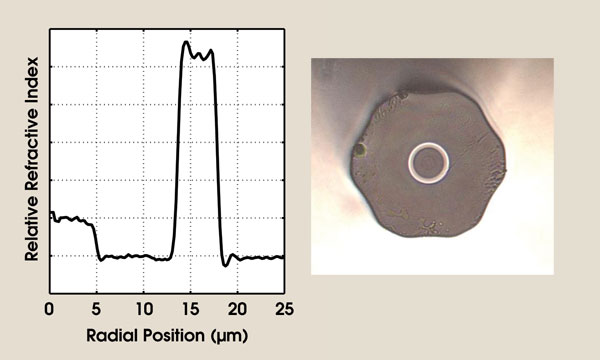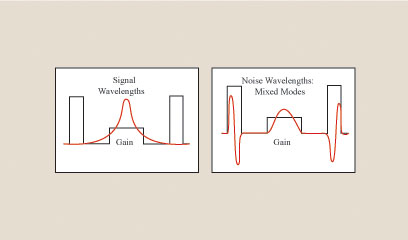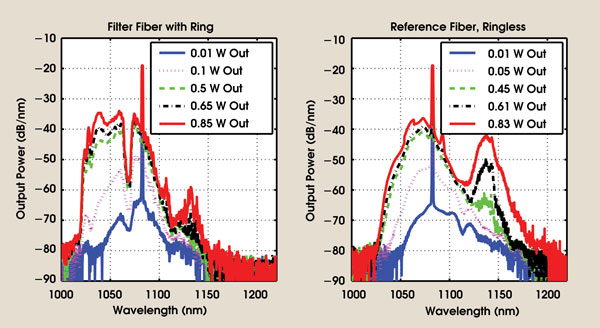Raman wavelength is selectively coupled out of fiber core.
Breck Hitz
Stimulated Raman scattering (SRS) is a major impediment to high-power operation of fiber lasers and amplifiers. Recently, researchers at OFS Laboratories in Somerset, N.J., demonstrated how a specially designed, ytterbium-doped fiber can suppress scattering by coupling the Raman wavelength out of the fiber core.

Figure 1. The high-index ring surrounding the core provided wavelength-selective filtering that suppressed stimulated Raman scattering (left). The fiber’s star-shaped cladding had nothing to do with the Raman suppression; it avoided circularly symmetrical pump-light modes that would not illuminate the core (right). Images reprinted with permission of Optics Letters.
They designed the fiber with a germanium-doped, high-index ring surrounding the fiber core (Figure 1). Conceptually, the Raman wavelength, but not the signal, is coupled from the core into the ring. This is accomplished by phase-matching the Raman wavelength such that the Raman light is guided in mixed core-ring modes, while the signal is guided in a pure-core mode (Figure 2).
The mixed core-ring modes are susceptible to numerous loss mechanisms, including bend loss and scattering, but the primary impediment to the Raman wavelength arises not from these mechanisms, but from the fact that roughly half the light is traveling in the ring, where it experiences no gain. In other words, because it is propagating in both the core and the ring, the Raman wavelength sees about half the gain that the signal wavelength sees.

Figure 2. The researchers designed the fiber so that the Raman wavelength, but not the signal, was phase-matched for propagation in modes that had significant field amplitude in the high-index ring. The field propagating in the ring experienced no gain.
To quantify the suppression of the Raman wavelength, the investigators pumped both a fiber with the specially designed ring and one without the ring and observed the spectra of amplified spontaneous emission (ASE) from both fibers. In an ytterbium-doped silica fiber, the laser gain peaks at ~1080 nm and the SRS signal occurs at a longer wavelength, ~1135 nm. Experimentally, the researchers saw a significantly less ASE gain at 1135 nm in the fiber with the ring, indicating that 1135-nm power was being coupled into the mixed core-ring modes.
The discrimination against the ~1135-nm Raman wavelength was far less obvious in straightforward transmission measurements than in the ASE measurements. The scientists expected that result because the dominant discrimination mechanism — the reduced gain for the mixed modes — disappears in the absence of pump light.
Analyzing the propagation modes theoretically, they achieved only qualitative agreement between their model and their experimental results. They attribute the lack of precise agreement to the simplistic nature of their model and to inaccuracies in their measurement of the fiber’s index profile, which they believe can be refined with further work.

Figure 3. In a side-by-side comparison, a fiber amplifier with the specially designed fiber (left) showed much less Raman signal — at ~1135 nm — than the reference amplifier with a regular fiber (right).
To demonstrate the effectiveness of their scheme in an actual amplifier, the researchers constructed two ytterbium-doped fiber amplifiers, one with the high-index ring and the other without. They pumped both amplifiers at 915 nm and seeded both with 1083-nm signal pulses. Although some SRS signal was present in both amplifiers, its amplitude was far lower in the amplifier with the high-index ring (Figure 3).
Optics Letters, Sept. 1, 2006, pp. 2550-2552.